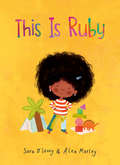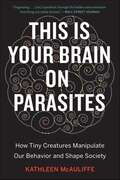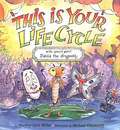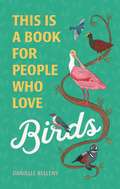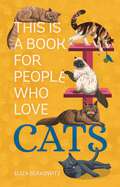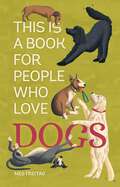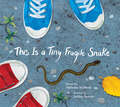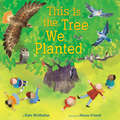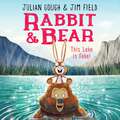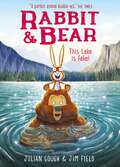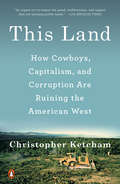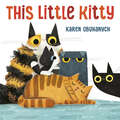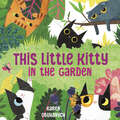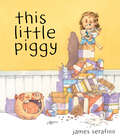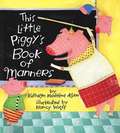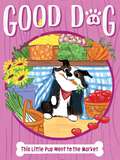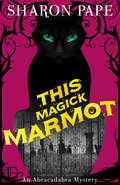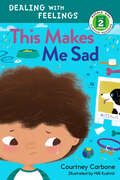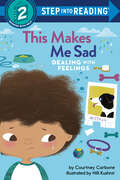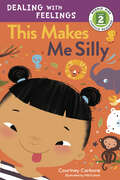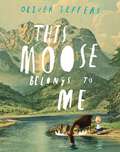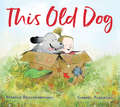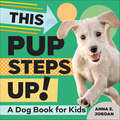- Table View
- List View
This Is Ruby
by Sara O'LearyRuby is curious about her world and has big ideas about how it works. A delightful picture book celebration of science and creativity, and a welcome companion to Sara O'Leary's beloved This Is Sadie.Ruby is a little girl with a sense of curiosity and enthusiasm that's too big to contain! Ruby is always busy -- she loves to make things, watch things grow and figure out how things work, with her dog Teddy by her side. And Ruby has lots of ideas about what she wants to be: maybe an animal conservationist? Or an archaeologist? She's great at excavating (i.e. digging holes). Or maybe an inventor? She's already invented a book with smells instead of words (so dogs can read it) and a time machine (the dinosaurs did have feathers after all, and the future is looking wild). This is Ruby, and this is her world.
This Is Your Brain On Parasites: How Tiny Creatures Manipulate Our Behavior and Shape Society
by Kathleen McAuliffe“Engrossing . . . [An] expedition through the hidden and sometimes horrifying microbial domain.” —The Wall Street Journal Parasites can live only inside another animal and, as Kathleen McAuliffe reveals, these tiny organisms have many evolutionary motives for manipulating the behavior of their hosts. With astonishing precision, parasites can coax rats to approach cats, spiders to transform the patterns of their webs, and fish to draw the attention of birds that then swoop down to feast on them. We humans are hardly immune to their influence. Organisms we pick up from our own pets are strongly suspected of changing our personality traits and contributing to recklessness and impulsivity—even suicide. Germs that cause colds and the flu may alter our behavior even before symptoms become apparent. Parasites influence our species on the cultural level, too. Drawing on a huge body of research, McAuliffe argues that our dread of contamination is an evolved defense against parasites. The horror and revulsion we are programmed to feel when we come in contact with people who appear diseased or dirty helped pave the way for civilization, but may also be the basis for major divisions in societies that persist to this day. This Is Your Brain on Parasites is both a journey into cutting-edge science and a revelatory examination of what it means to be human. “If you’ve ever doubted the power of microbes to shape society and offer us a grander view of life, read on and find yourself duly impressed.” —Bookforum “Fascinating—and full of the kind of factoids you can’t wait to share.” —Scientific American“Humorous, inspiring, and macabre, this is infectious reading in the tradition of giants like Robert S. Desowitz and Jared Diamond.” —Michael A. Huffman, Primate Research Institute, Kyoto University
This Is Your Life Cycle
by Heather Lynn MillerIn this hilarious and inventive picture book, your host, Bob Beetle, takes special guest Dahlia Dragonfly down memory lane, highlighting the most influential creatures and experiences during her time as a nymph. You’ll meet three mystery guests, who’ll share their personal stories about Dahlia, and along the way you’ll find out about the different stages of a dragonfly’s life, the various predators they face, what they eat, and other amazing facts. And who knows what else might happen because, as always, we’ll be filming live in front of our all-insect studio audience! Filled with fun and humor, this book is as entertaining as it is informative. So please join us for an evening of laughter, thrills, and the thorax-warming memories that make every life cycle its own fascinating story.
This Is a Book for People Who Love Birds (This Is a Book for People Who Love)
by Danielle BellenyFull of bird watching basics, fun facts, and illustrated species profiles, This Is a Book for People Who Love Birds is a joyful celebration of our feathered friends!For seasoned spotters and backyard hobbyists alike, this charming guide offers an accessible look at the irresistible world of birding. Wildlife biologist and co-founder of Black Birders Week Danielle Belleny walks readers through the essentials of bird watching, from equipment to locations, offering new ideas for finding avian friends wherever you may be. Engaging profiles of North American bird species, from cardinals and blue jays to raptors and sea birds, are accompanied by whimsical illustrations sure to spark the imaginations of birders from coast to coast. Deeply researched and accessible to enthusiasts of all levels of experience, This Is a Book for People Who Love Birds is an essential addition to every bird lover's field library.
This Is a Book for People Who Love Cats (This Is a Book for People Who Love)
by Eliza BerkowitzFull of feline facts, lessons translating cat behavior, and illustrated breed profiles, This Is a Book for People Who Love Cats is a joyful celebration of all nine lives of cat friends! For cat lovers of all ages, this beautifully illustrated guide offers an informative look at the world and lives of cats. Cat enthusiast Eliza Berkowitz highlights why we love cats so much, how cats became domesticated, and just what they're doing and saying with their odd behavior. Fascinating profiles of cat breeds, from Maine Coons and Calicos to Bengals and Egyptian Maus, are accompanied by charming illustrations that will make you fall in love with cats all over again... and again. Comprehensively researched and shared in an accessible, appealing format, This Is a Book for People Who Love Cats is a purr-fect addition to every cat lover's library.
This Is a Book for People Who Love Dogs (This Is a Book for People Who Love)
by Meg FreitagDog lovers rejoice! This Is a Book for People Who Love Dogs is a canine celebration featuring illustrated breed profiles, a history of how dogs evolved, and an exploration of the joys of sharing your life with a dog. For dog lovers new and old, this gorgeous guide takes readers on a walk through the wonders of our four-legged friends. Author Meg Freitag shares all about the lives of dogs, from deciphering dog behavior and tracing the long history of companionship between humans and dogs. Dog breeds—including collies, corgies, and golden retrievers—are profiled with spirited illustrations that'll leave you aching to bring another dog home. Thoroughly researched and presented in a warm, charming style, This Is a Book for People Who Love Dogs is a must-have for everyone who cherishes their furry friends.
This Is a Book to Read with a Worm
by Jodi Wheeler-ToppenIf you can find a worm, then you can be a biologist!Foster a love of animals and science with this charming activity guide for finding and observing earthworms. Hands-on experiments help young biologists answer questions like "Which end is which?" and "Do worms make noise?" Insider tips encourage readers to think like a scientist and handle living things with care. Equally entertaining with or without a worm friend.
This Is a Tiny Fragile Snake
by Nicholas RuddockFifteen poems explore close encounters with animals … and choosing to respond tenderly. Whether it’s helping a hummingbird escape, respecting a bear’s habitat, admiring a heron’s beauty, or giving way to ants at a picnic, the human response in these poems is to do no harm, and to help whenever possible. The poems follow a seasonal progression, ending with a final poem that imagines where each animal might be on a winter night. Inspired by personal experiences, Nicholas Ruddock’s poems are simply written, with a pleasing rhyme, and fun to read aloud. In the spirit of the text, Ashley Barron’s cut-paper collage illustrations portray each creature with respectful realism, in environments ranging from rural and wild to urban and suburban. A delightful dip into poetry for young animal lovers! Key Text Features illustrations poems Correlates to the Common Core State Standards in English Language Arts: CCSS.ELA-LITERACY.RL.K.4 Ask and answer questions about unknown words in a text. CCSS.ELA-LITERACY.RL.K.6 With prompting and support, name the author and illustrator of a story and define the role of each in telling the story. CCSS.ELA-LITERACY.RL.1.4 Identify words and phrases in stories or poems that suggest feelings or appeal to the senses.
This Is the Tree We Planted
by Kate McMullanLearn about all of the animals that coexist in just one tree that a classroom planted in this fun, informative, cumulative picture book in the tradition of This is the House That Jack Built.A class plants a tree in the playground, and together, they watch it grow. There is no shortage of action to observe in its branches: a robin protecting her eggs from a squirrel and her kits, a lizard stalking a spider, and a hawk swirling around overhead. Within this tree is an entire ecosystem, all created by the class who planted it. Beloved children's book creator Kate McMullan has crafted a story that will encourage kids to cultivate a love of nature as they observe the world living inside their backyards.
This Lake is Fake!: Book 6 (Rabbit and Bear #6)
by Julian GoughGorgeously illustrated and with a classic feel, this is a brilliantly funny story of a rabbit and a bear ... and how friends can manage in a not-quite-perfect world. Ideal for readers moving on from picture books.'A perfect animal double-act.' The Times, Book of the Week Rabbit is fed up. Spring has come, but it's not as perfect as he thought it would be. Bear thinks that if they work hard, they can make it better. But Rabbit has a Plan. He sets off across the lake in search of a perfect world. Crossing the water together, Rabbit and Bear learn many things, and discover that their perfect world may be closer at hand than Rabbit had thought. A story of hope, friendship, and an entire island made of bird droppings.'Rabbit's Bad Habits is a breath of fresh air in children's fiction, a laugh-out-loud story of rabbit and wolf and bear, of avalanches and snowmen. The sort of story that makes you want to send your children to bed early, so you can read it to them.' Neil GaimanRead all the Rabbit and Bear books:1. Rabbit's Bad Habits2. The Pest in the Nest3. Attack of the Snack4. A Bite in the Night5. A Bad King is a Sad Thing6. This Lake is Fake!
This Lake is Fake!: Book 6 (Rabbit and Bear #6)
by Julian GoughGorgeously illustrated and with a classic feel, this is a brilliantly funny story of a rabbit and a bear ... and how friends can accept that the world isn't always perfect. Ideal for readers moving on from picture books.'A perfect animal double-act.' The Times, Book of the Week Rabbit is fed up. Spring has finally arrived, but it's not as perfect as he hoped it would be. Bear thinks that if they work hard, they can improve things, a bit. But Rabbit has a MUCH better plan. He sets off across the lake in search of a Perfect World ...Meet Rabbit and Bear in the classic series that has taken the world by storm: this is a story of hope, friendship, a very long journey with no breakfast, and an entire island made of ... of ... wait ... is that chocolate? It looks like chocolate ... 'Rabbit's Bad Habits is a breath of fresh air in children's fiction, a laugh-out-loud story of rabbit and wolf and bear, of avalanches and snowmen. The sort of story that makes you want to send your children to bed early, so you can read it to them.' Neil GaimanRead all the Rabbit and Bear books:1. Rabbit's Bad Habits2. The Pest in the Nest3. Attack of the Snack4. A Bite in the Night5. A Bad King is a Sad Thing6. This Lake is Fake!
This Land: How Cowboys, Capitalism, and Corruption are Ruining the American West
by Christopher KetchamA hard-hitting look at the battle now raging over the fate of the public lands in the American West--and a plea for the protection of these last wild placesThe public lands of the western United States comprise some 450 million acres of grassland, steppe land, canyons, forests, and mountains. It's an American commons, and it is under assault as never before.Journalist Christopher Ketcham has been documenting the confluence of commercial exploitation and governmental misconduct in this region for over a decade. His revelatory book takes the reader on a journey across these last wild places, to see how capitalism is killing our great commons. Ketcham begins in Utah, revealing the environmental destruction caused by unregulated public lands livestock grazing, and exposing rampant malfeasance in the federal land management agencies, who have been compromised by the profit-driven livestock and energy interests they are supposed to regulate. He then turns to the broad effects of those corrupt politics on wildlife. He tracks the Department of Interior's failure to implement and enforce the Endangered Species Act--including its stark betrayal of protections for the grizzly bear and the sage grouse--and investigates the destructive behavior of U.S. Wildlife Services in their shocking mass slaughter of animals that threaten the livestock industry. Along the way, Ketcham talks with ecologists, biologists, botanists, former government employees, whistleblowers, grassroots environmentalists and other citizens who are fighting to protect the public domain for future generations. This Land is a colorful muckraking journey--part Edward Abbey, part Upton Sinclair--exposing the rot in American politics that is rapidly leading to the sell-out of our national heritage. The book ends with Ketcham's vision of ecological restoration for the American West: freeing the trampled, denuded ecosystems from the effects of grazing, enforcing the laws already in place to defend biodiversity, allowing the native species of the West to recover under a fully implemented Endangered Species Act, and establishing vast stretches of public land where there will be no development at all, not even for recreation.
This Little Kitty
by Karen ObuhanychWith a bold, graphic style and a bouncy, rhyming text, this picture book catches rascally kittens being their adorable (and mischievous!) selves from morning to nap to night.This little kitty starts the day and meows, &“Wake up! It&’s time to play! All the little kitties get out of bed. Their bellies grumble—it&’s time to be fed." Read along as these frisky felines pounce and play, claw and climb, and snack and sleep—until daylight fades and these little kitties are ready to receive some love and affection. Filled with bright and playful illustrations, here is an adorable picture book by debut author-illustrator Karen Obuhanych, featuring many delightful cats—all brimming with purrsonality—that will charm cat lovers and kids alike.
This Little Kitty in the Garden
by Karen ObuhanychSpring is blooming, and what better way for rascally kittens to celebrate than by causing mischief in the garden in this charming picture book!Spring has sprung on Sakura Way.The five little kittles will garden today!Read along as these frisky felines plant seeds, pounce and play, claw and climb, and splish, splash and swirl—until they end their day asleep in the garden bed. Filled with bright and playful illustrations, here is an adorable picture book that introduces kids to the wonders of spring as they spend time in the garden with these delightful cats—all brimming with cattitude. Here is a picture book sure to charm cat lovers and kids alike.
This Little Piggy
by James SerafinoIf You Give a Mouse a Cookie meets Stuck in this clever laugh-riot that honors an underrated superstar in kid-cuisine -- cereal -- and the girl who just can't eat enough of it . . . no matter how large a mess she leaves in her wake!"[A] buoyant tale of togetherness." --KirkusOnce there was a girl who only ate cereal. This kid LOVED cereal. But lots of cereal can make a BIG mess and get a girl in trouble. So she asks the dog for help cleaning up her crumbs, but the dog soon fills up. Then she asks a cat, but the cat only wants to nap. One after another, animals try to help...but the mess is too large!Then the girl meets a pig...Perfect for the fan of Dragons Love Tacos, If You Give a Mouse a Cookie, and Oliver Jeffers' Stuck.
This Little Piggy's Book of Manners
by Kathryn Madeline AllenSome little pigs remember their manners, and others do not. A humorous twist on "This Little Piggy Goes to Market" all about different kinds of manners that children remember, and also forget.
This Little Pup Went to the Market (Good Dog #14)
by Cam HigginsIn this adorable fourteenth book of the Good Dog series, Bo and his family visit the farmer&’s market!What&’s not to love about the smell of fresh-baked bread, gleaming piles of fruit, and homemade treats? Bo is having a splendid time exploring until he realizes one of his animal friends from the farm has accidentally tagged along. Our pup finds that he&’s in for a day of locally-grown chaos and fun. With easy-to-read language and illustrations on almost every page, the Good Dog chapter books are perfect for emerging readers.
This Magick Marmot (An Abracadabra Mystery #5)
by Sharon PapePraise for Magick & Mayhem, the first Abracadabra mystery&“Spellbinding, with magical prose, a wizardly plot, and a charming sleuth.&”—Janet Bolin, national bestselling author &“A charming, must-read mystery with enchanting characters.&”—Rose Pressey, USA Today bestselling author &“Magic, Merlin, and murder are a great mix for this fun debut cozy.&”—Lynn Cahoon, New York Times and USA Today bestselling author A fatal case of school spirit . . . Kailyn Wilde, owner of the Abracadabra potion shop, feels some dread anticipating her ten-year high school reunion at the new hotel in New Camel—but it turns out even worse than she feared. Running into her very first boyfriend is pleasant enough. Chatting with Ashley—who still can&’t let go of a tragedy that happened on prom night—is a bit more uncomfortable. But the worst part comes when one of Kailyn&’s oldest friends is found dead in the ladies&’ room. Soon this upstate New York town is in an uproar. And with some help from time-traveling wizard Merlin—who has adopted an unusual and alluring creature as his familiar—it&’s up to Kailyn to identify the alumnus most likely to commit murder . . . &“Pape has a sure‑handed balance of humor and action.&” —Julie Hyzy, New York Times bestselling author [For POD:Don&’t Miss these Abracadabra Mysteries!Show cover: MAGICK AND MAYHEM/MAGICKAL MYSTERY LORE] Visit us at www.kensingtonbooks.com
This Magick Marmot (An Abracadabra Mystery #5)
by Sharon PapePraise for Magick & Mayhem, the first Abracadabra mystery&“Spellbinding, with magical prose, a wizardly plot, and a charming sleuth.&”—Janet Bolin, national bestselling author &“A charming, must-read mystery with enchanting characters.&”—Rose Pressey, USA Today bestselling author &“Magic, Merlin, and murder are a great mix for this fun debut cozy.&”—Lynn Cahoon, New York Times and USA Today bestselling author A fatal case of school spirit . . . Kailyn Wilde, owner of the Abracadabra potion shop, feels some dread anticipating her ten-year high school reunion at the new hotel in New Camel—but it turns out even worse than she feared. Running into her very first boyfriend is pleasant enough. Chatting with Ashley—who still can&’t let go of a tragedy that happened on prom night—is a bit more uncomfortable. But the worst part comes when one of Kailyn&’s oldest friends is found dead in the ladies&’ room. Soon this upstate New York town is in an uproar. And with some help from time-traveling wizard Merlin—who has adopted an unusual and alluring creature as his familiar—it&’s up to Kailyn to identify the alumnus most likely to commit murder . . . &“Pape has a sure‑handed balance of humor and action.&” —Julie Hyzy, New York Times bestselling author [For POD:Don&’t Miss these Abracadabra Mysteries!Show cover: MAGICK AND MAYHEM/MAGICKAL MYSTERY LORE] Visit us at www.kensingtonbooks.com
This Makes Me Sad: Dealing with Feelings (Rodale Kids Curious Readers/Level 2 #2)
by Courtney CarboneIf feeling blue isn’t bad enough, it’s even worse without your best furry friend. This Makes Me Sad follows a young boy after he accidentally lets his dog, Kit, loose from the yard. Despite his parents’ attempt to find her, nothing can cheer up the boy. His favorite things, like a pretty sunset, going to the park, and his beloved teddy bear, just make him more sad. Even happy memories of Kit no longer feel good. With help from his family, the boy must learn to accept and express how he’s feeling inside. And by dealing with his feelings, he might just be able to do some good until Kit comes home. Easy-to-read text and evocative illustrations make this relatable second story in the Dealing with Feelings series a perfect practice in emotional maturity for kids, and it includes 2 sheets of colorful stickers!
This Makes Me Sad: Dealing with Feelings (Step into Reading)
by Courtney CarboneIf feeling blue isn’t bad enough, it’s even worse without your best furry friend. This Makes Me Sad follows a young boy after he accidentally lets his dog, Kit, loose from the yard. Despite his parents’ attempt to find her, nothing can cheer up the boy. His favorite things, like a pretty sunset, going to the park, and his beloved teddy bear, just make him more sad. Even happy memories of Kit no longer feel good. With help from his family, the boy must learn to accept and express how he’s feeling inside. And by dealing with his feelings, he might just be able to do some good until Kit comes home. Easy-to-read text and evocative illustrations make this relatable second story in the Dealing with Feelings series a perfect practice in emotional maturity for kids.
This Makes Me Silly (Rodale Kids Curious Readers/Level 2 #4)
by Courtney CarboneIn This Makes Me Silly, a little girl and her brother go with their family to the zoo, only to find that they can't stop laughing! Between making funny monkey faces and stretching their arms for elephant trunks, it's no wonder they snort out their milk at lunch. The little girl doesn't see any harm in her silliness at first, but when she scares an animal by shouting and banging on the glass, she learns that there's a time and place to be silly (like at the zoo playground), and a time and place to be calm (when animals are sleeping).The Dealing with Feelings series of early readers are designed to give voice to what’s brewing inside. Through short, simple text and repetitive observational phrases, the child will learn to name their emotions as they also learn to read.
This Moose Belongs to Me
by Oliver JeffersFrom the illustrator of the #1 smash hit The Day the Crayons Quit comes the age-old tale of a boy and his moose . . .Wilfred is a boy with rules. He lives a very orderly life. It's fortunate, then, that he has a pet who abides by rules, such as not making noise while Wilfred educates him on his record collection. There is, however, one rule that Wilfred's pet has difficulty following: Going whichever way Wilfred wants to go. Perhaps this is because Wilfred's pet doesn't quite realize that he belongs to anyone.A moose can be obstinate in such ways.Fortunately, the two manage to work out a compromise. Let's just say it involves apples.Oliver Jeffers, the bestselling creator of Stuck and The Incredible Book Eating Boy, delivers another deceptively simple book sure to make kids giggle.
This Old Dog
by Martha BrockenbroughWhen so much of the world is new, you want to go slowly… to stop and enjoy everything; hills to roll down, perfect-sized rocks, trees that seem to whisper their thoughts. It’s the same when you're much, much older, and every time 'round the seasons seems precious. Yet the folks in the middle (we know who we are) are always rushing, rushing, rushing. Appointments to make, trains to catch, places to be, FAST.That's what makes the bond between old dog and the little girl so special. From the time she takes her first steps, old dog finds someone – at last! – who wants to go at the same pace he does. To walk with everywhere, through this wide, wonderful world.A love song to the bond between young and old, this book will make you want to sit right down and read to someone you care about.
This Pup Steps Up!: A Dog Book for Kids
by Anna E. JordanPups are perfect friends, it's true! See what else a dog can do in this early-learning book for ages 0 to 3This Pup Steps Up! is a fun rhyming romp through the world of dogs, full of cute and colorful photos to help your little one learn more about their four-legged friends. Your toddler or pre-K child will love discovering all the different things dogs can do—from working as service animals, herding sheep, and leading sleds to just being the perfect cuddle buddies. Of all the dog books for kids, this one is a paws-itively delightful introduction to one of their favorite animals!This fun and engaging dog book for kids includes:Photos of various dog breeds and different life stagesA narrative designed to engage toddlers and pre-K kidsBasic fun facts about dogsWhen it comes to dog books for kids, this one will get their tails wagging!
